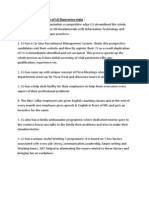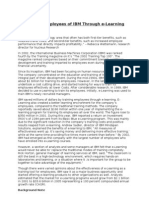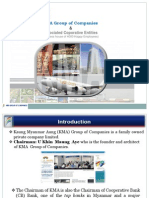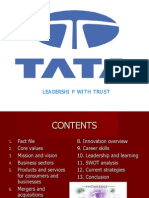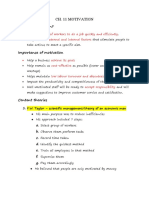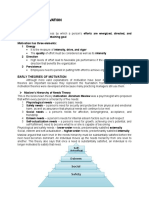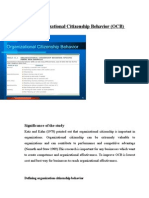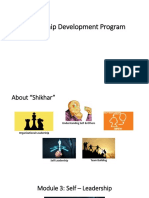Case Studies
Case Studies
Uploaded by
Madhu SharmaCopyright:
Available Formats
Case Studies
Case Studies
Uploaded by
Madhu SharmaCopyright
Available Formats
Share this document
Did you find this document useful?
Is this content inappropriate?
Copyright:
Available Formats
Case Studies
Case Studies
Uploaded by
Madhu SharmaCopyright:
Available Formats
Abstract:
Microsoft started its Indian operations in the year 1990 setting up Microsoft India Corporation (Pvt) Ltd in New Delhi. Later, Microsoft expanded its footprint in India by bringing all its six main units of business into the country. The headcount at Microsoft India Development Center (MSIDC) at Hyderabad grew from 20 in 1998 to more than 1,500 by the end of 2008, making it the company's second biggest development center in the world. Microsoft India's HR strategy was focused on building the organizational capability and strengthening employee engagement to leverage the limited human resources to achieve the company's mission. According to Microsoft India's HR growth model, HR was ultimately expected to be a change leader and business driver. Set in a context of a challenging global business environment, this case discusses the talent management and employee retention practices at Microsoft India, and its use of HR metrics to build accountability of the HR function toward business success.
Issues:
The HR function as a change leader and business driver. Aligning local HR practices to the corporate mission and global/local business environment. Talent management and employee retention in the Indian IT industry. Managing knowledge workers and their work-life balance. HR metrics and Return on Investment (RoI).
Contents:
Introduction Background Microsoft India's HR Approach Page No. 1 2 3
Human Resource Management Practices HR Metrics Followed by Microsoft India Conclusion Exhibits
4 7 8 10
Key Words:
Human capital management (HCM), Employee Value Proposition, HR metrics, Best Companies to Work For in India, Microsoft India Development Center (MSIDC), Employee surveys, Learning and development, Succession planning, Recruitment and selection, Talent acquisition and development, Performance evaluation, Work-life balance, Workforce diversity, Mentoring, Attrition and retention, Information Technology (IT) industry, Leadership development, Microsoft Global Technical Support Center (MSGTSC) We have a talent agenda and we need to, because in any intellectual property-driven business, our assets walk in and walk out every day. If we are to remain competitive, we have to give them a proper environment to shine through, so that they stay with us."1 - Ravi Venkatesan, Chairman, Microsoft India2. "Once a year, we take a deep dive to look at key people, key positions, the existing succession plan and developmental needs. We aim to identify or develop at least two 'ready now' and 'one move away' candidates for each key position. The idea is to facilitate planned career moves, especially for our leadership bench."3 - Joji Gill, Director-HR, Microsoft India. "My experience in Microsoft has been exhilarating and rewarding so far. The three things that I like the most about Microsoft India Global Technical Support Center(IGTSC) are - Employee first approach, transparency and numerous opportunities for growth - both in personal and professional space." 4 Rohit Gulati, an employee, Microsoft India.
Introduction
In 2008, Microsoft India Corporation Pvt. Ltd (Microsoft India), the Indian subsidiary of Microsoft Corporation (Microsoft), was ranked as number one in the list of 'Best Companies to Work for in India'5 surveyed jointly by Business Today6, Mercer LLC7, and Taylor Nelson Sofres (TNS) Global8.
Introduction Contd...
Microsoft India was also believed to be one of the most sought after companies for information technology (IT) professionals and graduates in India.9 In early 2009, Microsoft announced the layoff of five percent of its workforce worldwide, as it reported its first drop in revenues in its history of business spanning over three decades10. The company-wide cost cutting measures were applicable to some extent to its Indian operations, where the company laid off one percent (55 employees) of its total workforce.11 If the economic situation deteriorated further beyond a point, the company was prepared to prune its headcount further, globally as well as in India. Did the economic situation also warrant a change in Microsoft India's human resource (HR) practices? Or, were its strategic HR practices in alignment with the company's mission, values, and strategy?...
Background
Right from its humble beginning in 1975, Microsoft had been an innovator in computer software and related services. Its product portfolio included the Windows series of operating system software for clients and servers, the office productivity suite - MS Office, business applications software, games, and software for mobile phones and handheld devices...
Microsoft India's HR Approach
Managing human resources in the IT sector has been a challenge for most companies that have set up operations in India. These companies aimed to take advantage of the relatively low cost of technically competent labor in India as compared to the US and developed countries in Europe. There was a huge demand for skilled personnel in this sector, but companies confronted by a lack of sufficient numbers of skilled personnel to meet the demand...
Human Resource Management Practices
Recruitment and Selection Microsoft India recruited both fresh graduates from academic campuses and experienced professionals in the IT industry. For campus recruitments, the selection process included written tests and several rounds of personal interviews... Training and Development For trainees, Microsoft India conducted a training program named Leap Engineer Acceleration Program (LEAP) which imparted technical and personal skills required to carry out the job... Career Management Microsoft India provided both vertical and lateral growth prospects for its employees in all the six business units present in India... Flexible Work Timings Microsoft India followed a flexible work timings policy for its employees. A flexi-time policy enabled the employees to work according to their convenience liberating them from rigid work timings... Employee Retention at Microsoft Global Technical Support Center (MSGTSC) For employee retention, Microsoft India initiated various programs particularly in MSGSTC, Bangalore, where work was carried out around the clock (24 X 7) in order to provide technical support services to its customers in different nations and time zones...
Human Resource Management Practices Contd...
Compensation and Benefits Microsoft India provided offered compensation packages on par or higher than the industry standards based on the technical skills and experience of the candidates. Employee benefits were standardized across employees... Performance Management Microsoft India followed a candid process while evaluating the performance of employees and regarding their compensation packages. The process was transparent so as to enable employees to identify their performance levels and have a clear idea of what was required in terms of performance in
order to reach to the next level... Women's Empowerment Microsoft India conducted special recruitment drives exclusively for women in line with the overall IT industry's aim of raising the female-male ratio in the workforce... Work-Life Balance In 2007, Microsoft India launched a program called 'Bring Your Child To Work' in a move to improve work-life balance among its employees...
HR Metrics Followed by Microsoft India
In Microsoft India, metrics were developed to track and define the effectiveness of the HR function. Microsoft India HR policies aimed to maximize the value of human capital in achieving business growth by focusing on talent acquisition and development, management development, leadership development, and management of evolution of the Microsoft culture...
Conclusion
Though Microsoft India's HR practices received accolades from many quarters, the 'Best Employer Survey 2008' released by Dataquest said that overall employee satisfaction at Microsoft India was below the industry average in India...
Exhibits
Exhibit I: Microsoft's Mission and Value System Exhibit II: Microsoft India's Business Units Exhibit III: Microsoft India's Mission and Strategic Initiatives Exhibit IV: Microsoft India's Employees Satisfaction (as of September 2008) against Industry Average
You might also like
- KelloggsDocument33 pagesKelloggsdauvbafnaNo ratings yet
- Twitter HRM and OB StudyDocument6 pagesTwitter HRM and OB StudyLe MaNo ratings yet
- Bauer - Onboarding Power of ConnectionDocument10 pagesBauer - Onboarding Power of ConnectionBuluguTraianLucianNo ratings yet
- Tisco Od InterventionDocument7 pagesTisco Od InterventionManjeet Rai67% (3)
- Tutorial 9 - Introduction To Management - ControllingDocument6 pagesTutorial 9 - Introduction To Management - ControllingKeresh HallNo ratings yet
- Assignment OF Human Resource ManagementDocument13 pagesAssignment OF Human Resource ManagementAmit K Jaiswal100% (1)
- Mahindra Case Study PDFDocument10 pagesMahindra Case Study PDFmotogp191186No ratings yet
- Critical Analysis of HR Strategies of Taj Group of HotelDocument3 pagesCritical Analysis of HR Strategies of Taj Group of HotelShaika ShaheenNo ratings yet
- Microsoft India's HR Policies: BackgroundDocument2 pagesMicrosoft India's HR Policies: Backgroundgappu singh0% (1)
- Microsoft A Look at Strategic Human ResoDocument9 pagesMicrosoft A Look at Strategic Human ResoEva RlndnNo ratings yet
- Change Effort in Microsoft OrganizationDocument17 pagesChange Effort in Microsoft OrganizationSrinivas AdityaNo ratings yet
- Mahindra & MahindraDocument11 pagesMahindra & MahindraKannanAlagappanNo ratings yet
- ONIDADocument4 pagesONIDARebecca Martin0% (1)
- Samsung Has A Multi-Pronged Approach With Heavy Emphasis On Targeted Hiring. "ApproximatelyDocument4 pagesSamsung Has A Multi-Pronged Approach With Heavy Emphasis On Targeted Hiring. "ApproximatelyBothina MadkourNo ratings yet
- Training and Development - 1681715212-1Document1 pageTraining and Development - 1681715212-1Bhanvi Hardiya100% (1)
- Human Resource Management at Microsoft: Recruitment and Selection - in The BeginningDocument5 pagesHuman Resource Management at Microsoft: Recruitment and Selection - in The BeginningJayanta 1No ratings yet
- Infosys Case-Group07Document4 pagesInfosys Case-Group07SANCHIT NEMANo ratings yet
- Google VRIODocument4 pagesGoogle VRIOValentina GonsalvesNo ratings yet
- Assignment One Human Resource Management (MGT211) Deadline: 06/03/2021 at 23:59Document4 pagesAssignment One Human Resource Management (MGT211) Deadline: 06/03/2021 at 23:59habibNo ratings yet
- Innovative HR Practices in IndiaDocument6 pagesInnovative HR Practices in IndiaKamal MaheshwariNo ratings yet
- Dell IHRM PresentationDocument16 pagesDell IHRM PresentationLilyMSUNo ratings yet
- HDFC ProjectDocument68 pagesHDFC ProjectPrince KashyapNo ratings yet
- Training Employees of IBM Through E-LearningDocument6 pagesTraining Employees of IBM Through E-Learningshaan_bhaiNo ratings yet
- Infosys (A) : Strategic Human Resource ManagementDocument11 pagesInfosys (A) : Strategic Human Resource ManagementPratham MittalNo ratings yet
- Strategic Human Resources UGB 320Document13 pagesStrategic Human Resources UGB 320Vance RollinNo ratings yet
- Human Resource Management Practice in Microsoft CorporationDocument6 pagesHuman Resource Management Practice in Microsoft CorporationMahak SharmaNo ratings yet
- KMA Company Profile Presentation (Mar 2013)Document40 pagesKMA Company Profile Presentation (Mar 2013)Kenneth Kyaw Myat ThaNo ratings yet
- Infosys Case StudyDocument14 pagesInfosys Case StudyDeepNo ratings yet
- TATADocument25 pagesTATAanupamjeet kaur80% (5)
- Industrial Report On InfosysDocument14 pagesIndustrial Report On InfosysMitesh ChauhanNo ratings yet
- Financing Is Much More Than Just A Monetary Transaction. Every Transaction Has A Purpose, and Our Purpose Is To Finance HappinessDocument35 pagesFinancing Is Much More Than Just A Monetary Transaction. Every Transaction Has A Purpose, and Our Purpose Is To Finance HappinessProsanta Datta100% (1)
- Organizing For HRDDocument7 pagesOrganizing For HRD9934529377100% (2)
- Daimler HRMDocument20 pagesDaimler HRMDayanand Venkatachalam100% (1)
- Performance Management System Wipro Vs InfosysDocument18 pagesPerformance Management System Wipro Vs InfosysAnkita Aggarwal100% (1)
- Walmart 15Document36 pagesWalmart 15Arsalan chhipaNo ratings yet
- 3rd Semester - VU MBADocument63 pages3rd Semester - VU MBAHarshit badaliaNo ratings yet
- Omninos Technologies Internation Private LimitedDocument13 pagesOmninos Technologies Internation Private LimitedKavita ThakurNo ratings yet
- Org - Behaviour Ch.1Document21 pagesOrg - Behaviour Ch.1kavitachordiya86No ratings yet
- Training & Development Program On Employee of Jamuna Bank Limited''Document13 pagesTraining & Development Program On Employee of Jamuna Bank Limited''Shibajit Halder0% (1)
- Success in Business of Dian GomezDocument7 pagesSuccess in Business of Dian GomezChandima Liyanage100% (1)
- Chapters of Specialization - InfosysDocument65 pagesChapters of Specialization - InfosysShubham JadhavNo ratings yet
- Why? IBM Did This Because There Growth Strategy IncludesDocument2 pagesWhy? IBM Did This Because There Growth Strategy IncludesSaurabh KhadseNo ratings yet
- Human Resource Management Assignment: A Study On Microsoft Reshaping HR StrategiesDocument6 pagesHuman Resource Management Assignment: A Study On Microsoft Reshaping HR StrategiesdivyannthomasNo ratings yet
- MBA 550 FP Part II FinalDocument18 pagesMBA 550 FP Part II FinalFun Toosh345No ratings yet
- Infosys PresentationDocument20 pagesInfosys PresentationaarushikapNo ratings yet
- MIS Project Report FinalDocument61 pagesMIS Project Report FinalShahzad SaifNo ratings yet
- Case Study Sample Annotated 08.31.2015Document8 pagesCase Study Sample Annotated 08.31.2015Muhammad IqbalNo ratings yet
- HR Case Studies Part IDocument9 pagesHR Case Studies Part Ihappyhero86No ratings yet
- Report HRPDocument11 pagesReport HRPvvv Naina100% (1)
- Internship ReportDocument75 pagesInternship Reportgyanprakashdeb302No ratings yet
- Analysis On Impact of Strategic HRM in Recruitment and Talent Management Process of British American Tobacco (BAT) .Document36 pagesAnalysis On Impact of Strategic HRM in Recruitment and Talent Management Process of British American Tobacco (BAT) .Muntasir haque FayezNo ratings yet
- Human Resource Management Assignment Case Study - Job Analysis at Go-ForwardDocument11 pagesHuman Resource Management Assignment Case Study - Job Analysis at Go-ForwardHoàng Nam29No ratings yet
- MTP Case Analysis 1. Bharat Engineering Works Limited: 2. The Assistant Business ManagerDocument12 pagesMTP Case Analysis 1. Bharat Engineering Works Limited: 2. The Assistant Business ManagerMelsew BelachewNo ratings yet
- Nestle 170505192306 PDFDocument65 pagesNestle 170505192306 PDFHumayun JavedNo ratings yet
- Ihrm NotesDocument17 pagesIhrm NotesNida HammadNo ratings yet
- HRM in InsuranceDocument63 pagesHRM in InsuranceAnkita DharodNo ratings yet
- List of Dissertation Topics in Strategic ManagementDocument5 pagesList of Dissertation Topics in Strategic ManagementHelpOnWritingAPaperCanadaNo ratings yet
- MBA 410 Strategic Human Resource ManagmentDocument13 pagesMBA 410 Strategic Human Resource ManagmentMimiDorami100% (1)
- Resecruitment at ItcDocument70 pagesResecruitment at ItctechcaresystemNo ratings yet
- Training & Development Process of PranDocument8 pagesTraining & Development Process of PranJabid IqbalNo ratings yet
- Leading the Revolution (Review and Analysis of Hamel's Book)From EverandLeading the Revolution (Review and Analysis of Hamel's Book)No ratings yet
- Human Resource Utilization Is The Extent To WhichDocument12 pagesHuman Resource Utilization Is The Extent To WhichFaye Aseo100% (1)
- Shiferaw DibabaDocument90 pagesShiferaw DibabaTaklu Marama M. BaatiiNo ratings yet
- Factors Affecting Employee Retention: August 2017Document22 pagesFactors Affecting Employee Retention: August 2017Kristine Dianne VillaromanNo ratings yet
- Chapter 5 Performance AppraisalDocument20 pagesChapter 5 Performance AppraisaljuerulNo ratings yet
- Ch.11 MotivationDocument11 pagesCh.11 MotivationRosina KaneNo ratings yet
- BibliographyDocument11 pagesBibliographybhagathnagarNo ratings yet
- Spiritual Leadership - and Job SatisfactionDocument7 pagesSpiritual Leadership - and Job SatisfactionSabitha AnsifNo ratings yet
- Downloadable Morden HR CV TemplateDocument1 pageDownloadable Morden HR CV TemplateNyasha MangombeNo ratings yet
- Topic - 3 (Management Function - Staffing)Document6 pagesTopic - 3 (Management Function - Staffing)Saffa IbrahimNo ratings yet
- HRM - PPT - Ch. 01Document24 pagesHRM - PPT - Ch. 01Tasawar AliNo ratings yet
- Human Resource Management: Presented By: Govinddeep Singh Batra PGDM-1Document17 pagesHuman Resource Management: Presented By: Govinddeep Singh Batra PGDM-1Govind BatraNo ratings yet
- BPO & KPO Recruitment StrategyDocument1 pageBPO & KPO Recruitment Strategysivapriya28No ratings yet
- Chapter Five Staffing 5.1 DefinitionDocument9 pagesChapter Five Staffing 5.1 DefinitionMagarsa BedasaNo ratings yet
- Performance ManagementDocument26 pagesPerformance ManagementahamdNo ratings yet
- Lecture 21 - Behavioural Theory of LeadershipDocument25 pagesLecture 21 - Behavioural Theory of LeadershipekroopNo ratings yet
- Training Programs CareerTrack-Training PDFDocument1 pageTraining Programs CareerTrack-Training PDFMoh. Farid Adi PamujiNo ratings yet
- Learning Journal Unit OneDocument2 pagesLearning Journal Unit OneSamurawi HailemariamNo ratings yet
- Recruitment and SelectionDocument5 pagesRecruitment and SelectionShipra ShuklaNo ratings yet
- 360 Degree Performance AppraisalDocument14 pages360 Degree Performance AppraisalJyotsna Gautam100% (1)
- Background of The StudyDocument2 pagesBackground of The Studyasif taj100% (1)
- Management (Chapter 16)Document12 pagesManagement (Chapter 16)Jm100% (1)
- Training Need AssessmentDocument56 pagesTraining Need AssessmentNisha Kumari100% (1)
- Organizational Citizenship Behavior (OCB) : Significance of The StudyDocument7 pagesOrganizational Citizenship Behavior (OCB) : Significance of The StudyIneha ThindNo ratings yet
- Eduniversal Best Masters Ranking Human Resources Management - Western EuropeDocument4 pagesEduniversal Best Masters Ranking Human Resources Management - Western EuropeMiruna TataruNo ratings yet
- Module 3 - Self - Leadership Copy 2Document27 pagesModule 3 - Self - Leadership Copy 2sumantNo ratings yet
- BRM Research 2Document6 pagesBRM Research 2Mubashir KhanNo ratings yet
- What Is ManagementDocument1 pageWhat Is ManagementprravenaNo ratings yet




















